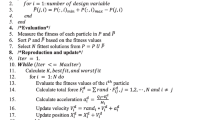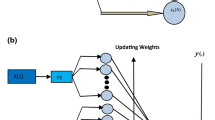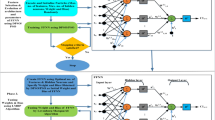Abstract
The current study is defined by two main aims. An effective strategy for improving local search is to combine the Set Algebra-Based Heuristic Algorithm (SAHA) algorithm with the Nelder-Mead simplex method. The approach outlined above, referred to as the Improved SAHA (ISAHA), and has the ability to produce superior outcomes. The multiplicative functional link artificial neural network (MFLANN) is an improved version of the functional link artificial neural network that promotes exploration by replacing the summing unit in the output layer with a multiplication unit. Moreover, the combination of ISAHA and MFLANN results in the development of ISAHA-MFLANN, a sophisticated hybrid forecasting model. The main assessment of the hybrid model rests on its ability to forecast complex and dynamic financial time series. It's possible to get around the problems that come with traditional learning-based MFLANN techniques by using MFLANN's advanced approximation features and ISAHA's resilient global search features together. Experimental verification using two stock market datasets and three currency exchange rates demonstrates the validity of the idea. The results show that the suggested improved SAHA hybrid learning works well at improving six standard benchmark functions. The ISAHA-MFLANN model is also statistically significant at accurately capturing the volatility that is inherent in the financial time series. In addition, it surpasses other models such as SAHA-MFLANN, Monarch Butterfly Optimization-MFLANN, Particle Swarm Optimization-MFLANN, Genetic Algorithm-MFLANN, Gradient Descent-MFLANN, Support Vector Machine (SVM), Multilayer Perceptron (MLP), and Auto Regressive Integrated Moving Average (ARIMA).





















Similar content being viewed by others
Data availability
The authors declare that all data analyzed and experimented during this study are available publicly in https://www.yahoofinance.com.
References
Hsu MW, Lessmann S, Sung MC, Ma T, Johnson JE. Bridging the divide in financial market forecasting: machine learners vs. financial economists. Expert Syst Appl. 2016;61:215–34. https://doi.org/10.1016/j.eswa.2016.05.033.
Nayak SC, Misra BB, Behera HS. ACFLN: artificial chemical functional link network for prediction of stock market index. Evol Syst. 2018;10(4):567–92. https://doi.org/10.1007/s12530-018-9221-4.
Nayak SC, Misra BB, Behera HS. Artificial chemical reaction optimization based neural net for virtual data position exploration for efficient financial time series forecasting. Ain Shams Eng J. 2018;9(4):1731–44. https://doi.org/10.1016/j.asej.2016.10.009.
Zhang G. Time series forecasting using a hybrid ARIMA and neural network model. Neurocomputing. 2003;50:159–75. https://doi.org/10.1016/s0925-2312(01)00702-0.
Adhikari R, Agrawal RK. A combination of artificial neural network and random walk models for financial time series forecasting. Neu Comput Appl. 2013;24(6):1441–9. https://doi.org/10.1007/s00521-013-1386-y.
Mostafa MM. Forecasting stock exchange movements using neural networks: Empirical evidence from Kuwait. Exp Syst Appl. 2010;37(9):6302–9. https://doi.org/10.1016/j.eswa.2010.02.091.
Nayak SC, Misra BB. Extreme learning with chemical reaction optimization for stock volatility prediction. Finan Innovat. 2020;6(1):1–23. https://doi.org/10.1186/s40854-020-00177-2.
Klassen P, Chen. Characteristics of the functional link net: a higher order delta rule net. IEEE International Conference on Neural Networks. 1988. https://doi.org/10.1109/icnn.1988.23885.
Patra JC, Thanh, NC, Meher PK. Computationally efficient FLANN-based intelligent stock price prediction system. 2009 International Joint Conference on Neural Networks; 2009 https://doi.org/10.1109/ijcnn.2009.5178594
Behera S, Nayak SC, Kumar AVSP. A comprehensive survey on higher order neural networks and evolutionary optimization learning algorithms in financial time series forecasting. Arch Comput Meth Eng 2023; 30(7): 4401–4448. https://doi.org/10.1007/s11831-023-09942-9
Alatas B. ACROA: Artificial Chemical Reaction Optimization Algorithm for global optimization. Exp Syst Appl. 2011;38(10):13170–80. https://doi.org/10.1016/j.eswa.2011.04.126.
Nayak SC, Das S, Misra BB. Development and performance analysis of fireworks algorithm-trained artificial neural network (FWANN): A case study on financial time series forecasting. In: Tan Y, editor. Handbook of Research on Fireworks Algorithms and Swarm Intelligence: IGI Global; 2020. p. 176–94. https://doi.org/10.4018/978-1-7998-1659-1.ch008.
Mirjalili S, Mirjalili SM, Hatamlou A. Multi-Verse Optimizer: a nature-inspired algorithm for global optimization. Neur Comput Appl. 2015;27(2):495–513. https://doi.org/10.1007/s00521-015-1870-7.
Yang L, Shami A. On hyperparameter optimization of machine learning algorithms: theory and practice. Neurocomputing. 2020;415:295–316. https://doi.org/10.1016/j.neucom.2020.07.061.
Rao RV, Savsani VJ, Vakharia DP. Teaching–learning-based optimization: an optimization method for continuous non-linear large scale problems. Informat Sci. 2012;183(1):1–15. https://doi.org/10.1016/j.ins.2011.08.006.
Venkata Rao R. Jaya: A simple and new optimization algorithm for solving constrained and unconstrained optimization problems. International Journal of Industrial Engineering Computations, 2016; 19–34. https://doi.org/10.5267/j.ijiec.2015.8.004
Rao RV, Pawar RB. Self-adaptive multi-population rao algorithms for engineering design optimization. Appl Artifi Intelli. 2020;34(3):187–250. https://doi.org/10.1080/08839514.2020.1712789.
He Y, Sun H, Wang Y, Zhang X, Mirjalili S. Set algebra — based algebraic evolutionary algorithm for binary optimization problems. Appl Soft Comput 2023, 143, 110425. https://doi.org/10.1016/j.asoc.2023.110425
Nayak SC, Kumar KV, Jilla K. ACRRFLN: Artificial Chemical Reaction of Recurrent Functional Link Networks for Improved Stock Market Prediction. Adv. Intell. Syst. Comput. 2019; 311–325. https://doi.org/10.1007/978-981-13-8676-3_28
Nayak SC, Misra BB. Estimating stock closing indices using a GA-weighted condensed polynomial neural network. Financial Innovat. 2018;4(1):1–22. https://doi.org/10.1186/s40854-018-0104-2.
White. Economic prediction using neural networks: the case of IBM daily stock returns. IEEE International Conference on Neural Networks. 1988. https://doi.org/10.1109/icnn.1988.23959.
Cao B, Zhao J, ZhihanLv YG, Yang P, Halgamuge SK. Multiobjective evolution of fuzzy rough neural network via distributed parallelism for stock prediction. IEEE Trans Fuzzy Syst. 2020;28(5):939–52. https://doi.org/10.1109/TFUZZ.2020.2972207.
Chakravarty S, Dash PK. A PSO based integrated functional link net and interval type-2 fuzzy logic system for predicting stock market indices. Appl Soft Comput. 2012;12(2):931–41. https://doi.org/10.1016/j.asoc.2011.09.013.
Nayak SC, Misra BB, Behera HS. Index prediction with neuro-genetic hybrid network: A comparative analysis of performance. 2012 International Conference on Computing, Communication and Applications 2012. https://doi.org/10.1109/iccca.2012.6179215
Anish C, Majhi B. Hybrid nonlinear adaptive scheme for stock market prediction using feedback FLANN and factor analysis. J Kor Stat Soc 2016; 45(1): 64–76. https://doi.org/10.1016/j.jkss.2015.07.002
Das S, Sahoo B, Nayak SC. Predictive ability of FLANN on BSE Index. Int J Pure Appl Mathemat. 2018;118(24):1–19.
Nayak SC, Misra BB. A chemical-reaction-optimization-based neuro-fuzzy hybrid network for stock closing price prediction. Finan Innovat 2019; 5(1). https://doi.org/10.1186/s40854-019-0153-1
Das S, Nayak SC, Sahoo B. Towards crafting optimal functional link artificial neural networks with rao algorithms for stock closing prices prediction. Comput Econ 2021; 60(1): 1–23. https://doi.org/10.1007/s10614-021-10130-9
Samal S, Dash R. Developing a novel stock index trend predictor model by integrating multiple criteria decision-making with an optimized online sequential extreme learning machine. Granul Comput. 2023;8:411–40. https://doi.org/10.1007/s41066-022-00338-x.
Rosillo R, Giner J, De la Fuente D. Stock market simulation using support vector machines. Journal of Forecasting 2014; 33(6), 488–500. https://doi.org/10.1002/for.2302
Majhi B, Shalabi H, Fathi M. FLANN based forecasting of S&P 500 Index. Informat Technol J 2005; 4(3), 289–292. https://doi.org/10.3923/itj.2005.289.292
Majhi R, Panda G, Sahoo G. Development and performance evaluation of FLANN based model for forecasting of stock markets. Exp Syst Appl. 2009; 36(3): 6800–6808. https://doi.org/10.1016/j.eswa.2008.08.008
Rout AK, Biswal B, Dash PK. A hybrid FLANN and adaptive differential evolution model for forecasting of stock market indices. KES. 2014;18(1):23–41. https://doi.org/10.3233/KES-130283.
Dash P, Satpathy H, Liew A, Rahman S (1997) A real-time short-term load forecasting system using functional link network. IEEE Trans Power Syst 12(2), 675–680. https://doi.org/10.1109/59.589648
Nayak SC, Ansari MD. COA-HONN: Cooperative Optimization Algorithm Based Higher Order Neural Networks for Stock Forecasting. Recent Adv Comput Sci Commun. 2021;14(7):2376–92. https://doi.org/10.2174/2213275912666190902121153.
Cao X, Zhao Z. Research on stock index forecasting based on ARIMA-GARCH and SVM mixed model. Highlights in Sci Eng Technol 2022; 4: 40–46. https://doi.org/10.54097/hset.v4i.843
Kang CY, Lee CP, Lim KM. Cryptocurrency price prediction with convolutional neural network and stacked gated recurrent unit. Data 2022; 7(11): 149. https://doi.org/10.3390/data7110149
Zhou Z, Song Z, Xiao H, Ren T. Multi-source data driven cryptocurrency price movement prediction and portfolio optimization. Exp Syst Appl 2023; 219, 119600. https://doi.org/10.1016/j.eswa.2023.119600
Rajabi S, Roozkhosh P, Farimani NM. MLP-based Learnable Window Size for Bitcoin price prediction. Appl Soft Comput. 2022;129:109584. https://doi.org/10.1016/j.asoc.2022.109584.
Seabe PL, Moutsinga CRB, Pindza E. Forecasting cryptocurrency prices using LSTM, GRU, and Bi-directional LSTM: a deep learning approach. Fract Fract 2023; 7(2), 203. https://doi.org/10.3390/fractalfract7020203
Zhong C, Du W, Xu W, Huang Q, Zhao Y, Wang M. LSTM-ReGAT: A network-centric approach for cryptocurrency price trend prediction. Dec Supp Syst 2023; 169, 113955. https://doi.org/10.1016/j.dss.2023.113955
Behera S, Nayak SC, Kumar AVSP. Evaluating the performance of metaheuristic based artificial neural networks for cryptocurrency forecasting. Comput Econ. 2023. https://doi.org/10.1007/s10614-023-10466-4.
Wei Y, Wang Y, Lucey BM, Vigne SA (2023) Cryptocurrency uncertainty and volatility forecasting of precious metal futures markets. J. Commodity Markets 29, 100305. https://doi.org/10.1016/j.jcomm.2022.100305
Orte F, Mira J, Sánchez MJ, Solana P. A random forest-based model for crypto asset forecasts in futures markets with out-of-sample prediction. Res Int Business Finance 2023; 64: 101829. https://doi.org/10.1016/j.ribaf.2022.101829
Sahu KK, Biswal GR, Sahu PK, Sahu SR, Behera HS. A CRO Based FLANN for forecasting foreign exchange rates using FLANN. Computa Intell Data Min. 2014;1:647–64. https://doi.org/10.1007/978-81-322-2205-7_60.
Sahu KK, Nayak SC, Behera HS. Multi-step-ahead exchange rate forecasting for south asian countries using multi-verse optimized multiplicative functional link neural networks. Karbala Int J Mod Sci 2021; 7(1). https://doi.org/10.33640/2405-609x.2278
Nayak SC. Development and performance evaluation of adaptive hybrid higher order neural networks for exchange rate prediction. Int J Intell Syst Appl 2017; 9(8): 71–85. https://doi.org/10.5815/ijisa.2017.08.08
Sahu KK, Nayak SC, Behera HS. Forecasting currency exchange rate time series with fireworks-algorithm-based higher order neural network with special attention to training data enrichment. Comput Sci 2020; 21(4). https://doi.org/10.7494/csci.2020.21.4.3474
Waheeb W, Ghazali R. A new genetically optimized tensor product functional link neural network: an application to the daily exchange rate forecasting. Evolutionary Intelligence, 2019; 12(4): 593–608. https://doi.org/10.1007/s12065-019-00261-2
Chakravarty S, Dash PK, RavikumarPandi V, Panigrahi BK. An evolutionary functional link neural fuzzy model for financial time series forecasting. Int J Appl Evolut Comput. 2011;2(3):39–58. https://doi.org/10.4018/jaec.2011070104.
Rout AK, Bisoi R, Dash P. A low complexity evolutionary computationally efficient recurrent Functional link Neural Network for time series forecasting. 2015 IEEE Power, Communication and Information Technology Conference (PCITC) 2015. https://doi.org/10.1109/pcitc.2015.7438230
Parida A, Bisoi R, Dash P, Mishra S (2015) Financial time series prediction using a hybrid functional link fuzzy neural network trained by adaptive unscented kalman filter. 2015 IEEE Power, Communication and Information Technology Conference (PCITC). https://doi.org/10.1109/pcitc.2015.7438229
Patra JC, van den Bos A. Modeling of an intelligent pressure sensor using functional link artificial neural networks. ISA Trans. 2000;39(1):15–27. https://doi.org/10.1016/S0019-0578(99)00035-X.
Sicuranza GL, Carini A. A Generalized FLANN Filter for Nonlinear Active Noise Control. IEEE Trans Audio, Speech, and Language Process 2011; 19(8): 2412–2417. https://doi.org/10.1109/tasl.2011.2136336
Haykin SS, Neural Networks and Learning Machines, third ed., Pearson Education, Upper Saddle River, 2009. http://www.mif.vu.lt/~valdas/DNT/Literatura/Haykin09/Haykin09.pdf.
Nordhausen K. The Elements of Statistical Learning: Data Mining, Inference, and Prediction, Second Edition by Trevor Hastie, Robert Tibshirani, Jerome Friedman. Int Stat Rev 2009; 77(3): 482–482. https://doi.org/10.1111/j.1751-5823.2009.00095_18.x
Garrigos G, Gower RM. Handbook of convergence theorems for (stochastic) gradient methods, 2023.
Jacot A, Gabriel F, Hongler C (2018) Neural tangent kernel: Convergence and generalization in neural networks. Advances in Neural Information Processing Systems, 31.
Holland J. Genetic algorithms. Scholarpedia. 2012;7(12):1482. https://doi.org/10.4249/scholarpedia.1482.
Meilia V, Setiawan BD, Santoso N. Extreme learning machine weights optimization using genetic algorithm in electrical load forecasting. Journal of Information Technology and Computer Science 2018; 3(1): 77–87. https://doi.org/10.25126/jitecs.20183154
Kennedy J, Eberhart R. Particle swarm optimization. Proceedings of ICNN'95 - International Conference on Neural Networks, Perth, WA, Australia, 1995, pp. 1942–1948 vol. 4. doi: https://doi.org/10.1109/ICNN.1995.488968.
Carneiro MG, Cheng R, Zhao L, Jin Y. Particle swarm optimization for network-based data classification. Neural Netw. 2019;110:243–55. https://doi.org/10.1016/j.neunet.2018.12.003.
Melingi SB, Mojjada RK, Tamizhselvan C, Surender R, Yazhinian S (2022) A self-adaptive monarch butterfly optimization (MBO) algorithm based improved deep forest neural network model for detecting and classifying brain stroke lesions. Res Biomed Eng 2022; 38(2): 647–660. https://doi.org/10.1007/s42600-022-00214-2
Chen S, Chen R, Gao J. A monarch butterfly optimization for the dynamic vehicle routing problem. Algorithms 2017; 10(3): 107. https://doi.org/10.3390/a10030107
Haupt RL. Sue Ellen Haupt: Practical Genetic Algorithms 2. Hoboken: John Wiley & Sons Inc; 2004.
Zhang F, He Y, Ouyang H, Li W. A fast and efficient discrete evolutionary algorithm for the uncapacitated facility location problem. Exp Syst Appl 2023; 213: 118978. https://doi.org/10.1016/j.eswa.2022.118978
He Y, Hao X, Li W, Zhai Q. Binary team game algorithm based on module operation for knapsack problem with a single continuous variable. Appl Soft Comput. 2021;103(5): 107180.
Wang X, Tsang EC, He Y, Zhu H. Discrete differential evolutions for the discounted 0–1 knapsack problem. Int J Bio-Inspired Comput. 2017;10(4):219. https://doi.org/10.1504/ijbic.2017.10008802.
Nelder JA, Mead R. A simplex method for function minimization. Comput J, 1965; 7(4), 308–313. https://doi.org/10.1093/comjnl/7.4.308
Lagarias JC, Reeds JA, Wright MH, Wright PE. Convergence properties of the Nelder–Mead simplex method in low dimensions. SIAM J Optim 1998; 9(1), 112–147. https://doi.org/10.1137/s1052623496303470
Nayak SC, Dehuri S, Cho SB. Intelligent financial forecasting with an improved chemical reaction optimization algorithm based dendritic neuron model. IEEE Access. 2022;10:130921–43. https://doi.org/10.1109/access.2022.3229314.
Little RJA, Rubin DB. Statistical analysis with missing data. 2. New York: Wiley; 2002.
Sahu KK, Sahu SR, Nayak SC, Behera HS. Forecasting foreign exchange rates using CRO based different variants of FLANN and performance analysis. Int J Comput Syst Eng. 2016;2(4):190. https://doi.org/10.1504/ijcsyse.2016.081380.
Das S, Nayak SC, Nayak SK, Sahoo B. A GA-based polynomial FLANN with exploration and incorporation of virtual data points for financial time series forecasting. Int J Recent Technol Eng. 2019;7(6):422–30.
García-Medina A, Aguayo-Moreno E. LSTM–GARCH Hybrid Model for the prediction of volatility in cryptocurrency portfolios. Comput Econ 2023. https://doi.org/10.1007/s10614-023-10373-8
Hussain K, Mohd Salleh MN, Cheng S, Naseem R. Common benchmark functions for metaheuristic evaluation: a review. JOIV: Int J Inform Vis. 2017;1(4–2):218–23. https://doi.org/10.30630/joiv.1.4-2.65
Funding
The authors declare that no funds, grants, or other support were received during the preparation of this manuscript.
Author information
Authors and Affiliations
Corresponding author
Ethics declarations
Conflicts of Interest
The authors have no relevant financial or non-financial interests to disclose.
Additional information
Publisher's Note
Springer Nature remains neutral with regard to jurisdictional claims in published maps and institutional affiliations.
Rights and permissions
Springer Nature or its licensor (e.g. a society or other partner) holds exclusive rights to this article under a publishing agreement with the author(s) or other rightsholder(s); author self-archiving of the accepted manuscript version of this article is solely governed by the terms of such publishing agreement and applicable law.
About this article
Cite this article
Behera, S., Kumar, A. & Nayak, S.C. Improved Set Algebra-Based Heuristic Technique for Training Multiplicative Functional Link Artificial Neural Networks for Financial Time Series Forecasting. SN COMPUT. SCI. 5, 567 (2024). https://doi.org/10.1007/s42979-024-02902-5
Received:
Accepted:
Published:
DOI: https://doi.org/10.1007/s42979-024-02902-5




